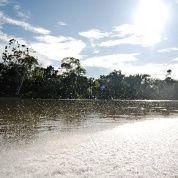Ecuador's Ministry of the Environment lashed out against a recent short documentary about oil exploration in the Yasuni National Park, accusing the filmmaker of a lack of professionalism, violating the country’s regulations, and making edits in bad faith to deliberately mislead the public.

British journalist Nina Bigalke published a video report alleging the construction of roads in Yasuni National Park are in violation of the license granted by the government to exploit oil in Block 31.
Bigalke's allegation that a “highway” has been built inside Yasuni parrots criticisms made by political opponents of the government of President Rafael Correa.
Bigalke's argument is centered around the idea that the exploration license did not permit the state-oil company Petroamazonas to build roads inside Yasuni, however that was never the case.
Ecuador has never denied having built a temporary road inside Yasuni, which it categorizes as an “ecological path,” but Bigalke confuses terms, using the words highway and road interchangeably. No permanent roads have been built inside the Yasuni National Park, say the government. Being an environmentally sensitive area, special consideration was made so that the environmental impact would be minimal and would cause no permanent effects.
“There are no 30 meter highways in Block 31 of Yasuni (National Park), only a four meter ecological access,” said Environment Minister Lorena Tapia in a tweet in response to the journalist's accusations.
En Yasuní B31 NO EXISTEN carreteras de 30m solo un acceso ecológico de 4m #LaVerdadYasuní http://t.co/dMdUXkOg3w pic.twitter.com/sCYUgZgLxV
— Lorena Tapia Núñez (@LorenaTapiaN)
October 5, 2015
In her video, Bigalke travels, without the necessary authorization, to Yasuni to “inspect” the site for herself. In doing so, Bigalke knowingly violates regulations established by authorities. In the article that accompanies her video, the British journalist acknowledges that access to Block 31 is restricted.
Instead of measuring the site in person, Bigalke presents her video evidence to experts from the University of Padua, who conclude, by looking at the video and satellite images, that the road clearing measures 30 meters.
The government accuses Bigalke of having “malicious intentions” for failing to properly asses the impact of the access road and for choosing to feature a segment of the road where vehicles pass each other, which is slightly wider than the rest of it.
A team of journalists with the Andes news agency visited Block 31 in May of this year and found that the work done inside Yasuni follows restrictions placed on Petroamazonas in order to minimize any environmental damage.
The journalists found that the clearing for the path measures 10 meters wide, which includes four meters paved for vehicles and six meters for a buried pipeline, which is already in the process of being reforested.
A commission from the Ecuadorean National Assembly, which included opposition politicians, also found that the access road inside Yasuni measures only 10 meters wide.
“But the problem is, it’s a big investment. So, where you have a road, you improve the road, you open new roads. It’s absurd to close a road,” Dr. Massimo De Marchi tells the journalist.
However the “ecological path” is built with temporary materials, including a material called “megadeck,” which is designed to be removable. There is no evidence whatsoever that the government intends to improve or keep the road open.
The government is aware that the building of a road, even a temporary one, could invite human settlements, poachers and illegal logging operations. This is precisely why access is restricted, a fact that Bigalke fails to mention.
In her video Bigalke says she met with Ecuadorean Secretary for Hydrocarbons Yvonne Fabara to “confront” her with the satellite images of the alleged road.
What Bigalke fails to disclose in the documentary is that her interview with Fabara was done over a year ago before the journalist ever visited Yasuni and that Bigalke asked for the interview under the pretense they would speak about the hydrocarbon sector, not the environmental impact of the access road in Block 31.
The film quality of her interview with Fabara is noticeably poor and only in her accompanying article does Bigalke acknowledge the interview took place in late 2014 and before she visited Yasuni.
Fabara says she is “outraged” with the journalist and accuses her of “distorting information.”
In a video response, the Ministry of the Environment accuses Bigalke of making edits to her interview in bad faith, deliberately taking Fabara's comments out of context with the intention of deceiving the public.
Bigalke refers to President Correa as “quasi-authoritarian,” repeating thoroughly debunked claims that the government is cracking down on dissent, citing biased reports by organizations such as Freedom House.
ANALYSIS: Debunking Human Rights Watch Latest Attack on Ecuador
To substantiate her argument, Bigalke cites the experience of the Yasunidos “environmental” organization: a declared opponent of the government. She states that the government rejected two-thirds of the signatures collected by the opposition-aligned group, but fails to mention that the pages of signatures were rife with inconsistencies and errors, with names of celebrities and fictional characters appearing on the list, while many names appeared more than once.
The Yasunidos were in fact given the opportunity to audit the revision of signatures, but refused to participate and instead attacked the vehicle carrying the collection of signatures in an effort to prevent them being transported.
Bigalke also makes claims about persecution of activists but provides no proof, citing only an unnamed activist who tells her, “The people that we are opposing, they tell us, ‘If you continue, you will be persecuted.’”
The Ministry of the Environment says this accusation is “totally baseless” and accused Bigalke of neglecting her “moral and professional” obligation to provide proof.
The Ministry of the Environment says experts from the ministry are on site year-round to ensure any environmental risk is minimized and in the interest of transparency maintains a website where information regarding oil exploration in Yasuni National Park.